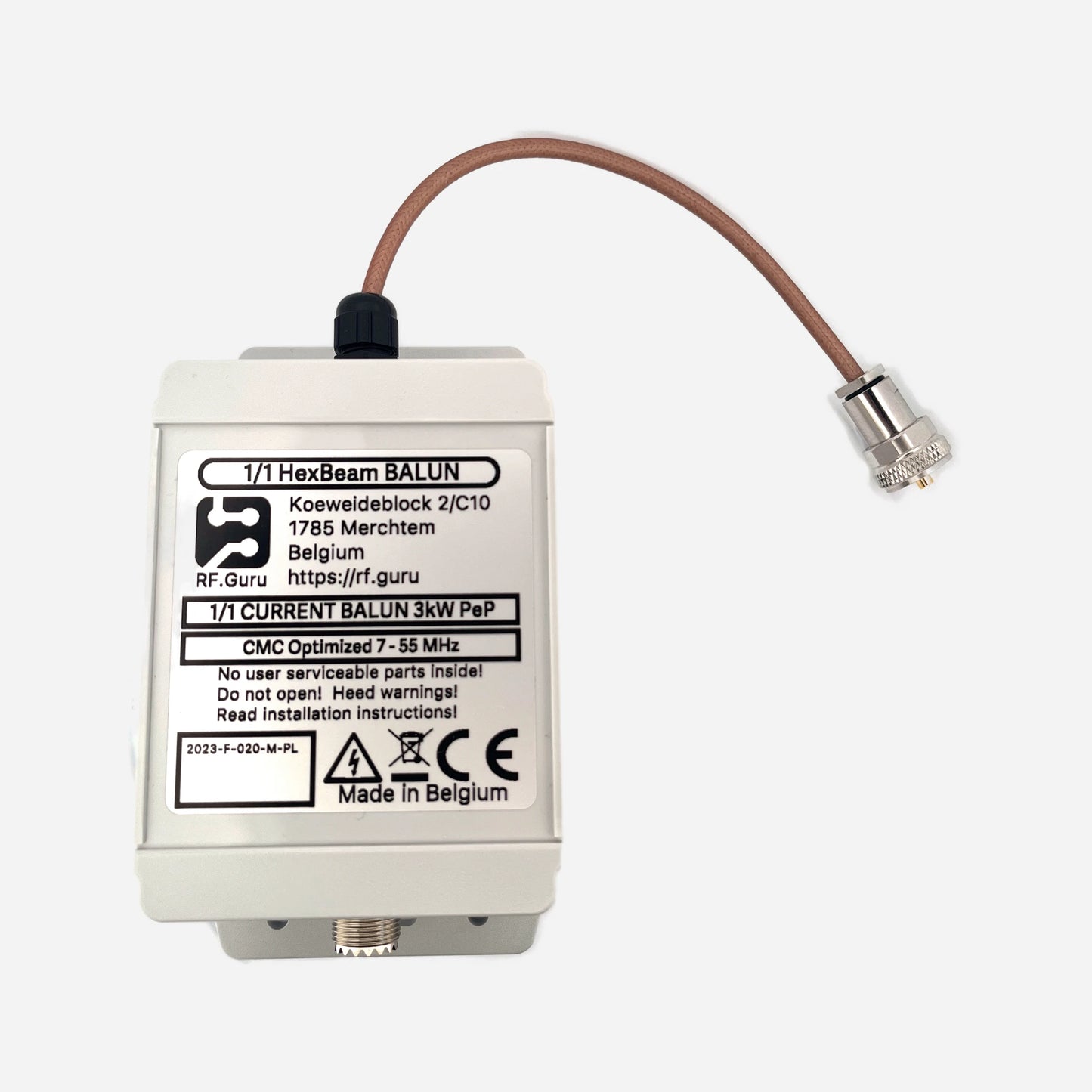RF Guru
5kW ICAS Dual Core High Power HexBeam 1:1 Current Balun or Choke
5kW ICAS Dual Core High Power HexBeam 1:1 Current Balun or Choke
Couldn't load pickup availability
Designed specifically for HexBeam and upper-HF applications, this 30–10 m dual-core current choke provides superior isolation across the higher amateur bands — and even extends smoothly through 6 m. Built on a stacked dual-core architecture and sealed inside a rugged polycarbonate enclosure with HV coating, custom gaskets, and a decompression valve, it’s engineered for permanent outdoor duty in high-power stations. All performance data below is based on real, verified measurements under load.
Baluns in a Nutshell
Why “Common-Mode” Is the Most Abused Term in Ham Radio
How Much Choking Do You Really Need — for RX and TX?
Optimized for HexBeam & Upper HF
Ideal as a feedline isolator for HexBeams, Yagis, and multiband verticals operating across 30 m to 10 m — including 6 m. This choke suppresses common-mode currents that distort beam patterns, raise noise floors, or detune antennas. A 30 cm PL-259 pigtail is factory-installed, and the enclosure may be ordered with either a PL-259 or N-type connector to match your system.
30–10 m Dual-Core Current Choke (5 kW ICAS)
Engineered for broad upper-HF coverage and consistent isolation from 30 through 10 m — plus effective suppression through 6 m. Impedance and dB values are conservative and verified under load.
| Band | Choking Impedance (Ω) | Impedance-Equivalent dB (from |Zc|) |
|---|---|---|
| 30 m | 3.0 kΩ | 41.6 dB |
| 20 m | 2.5 kΩ | 40.0 dB |
| 17 m | 2.3 kΩ | 39.3 dB |
| 15 m | 2.1 kΩ | 38.5 dB |
| 12 m | 1.9 kΩ | 37.6 dB |
| 10 m | 1.7 kΩ | 36.7 dB |
| *Impedance-Equivalent (dB) values are derived directly from measured |ZCM| using a 50 Ω common-mode source reference. Real antennas almost never present 50 Ω in common-mode, so these values represent the choke’s intrinsic suppression capability — not the attenuation of a specific antenna installation. More background: Why dB Attenuation Specs on Ham Chokes Are a Mess.* | ||
Maximum ICAS/CCS Power Ratings
| Connector Type | 160–40 m Band | 30–10 m Band | 6–2 m Band | Limiting Factor |
|---|---|---|---|---|
| PL-259 / UHF | ≈ 2.7 kW ICAS | ≈ 1.3 kW ICAS | ≈ 0.6 kW ICAS | Connector |
| Type-N | ≈ 10 kW ICAS | ≈ 5 kW ICAS | ≈ 2 kW ICAS | Coax |
| 7/16 DIN | ≈ 10 kW ICAS | ≈ 5 kW ICAS | ≈ 2 kW ICAS | Coax |
Construction Highlights
- Dual-core ferrite stack for extended magnetic and thermal overhead
- High-voltage internal coating to prevent corona discharge
- Polycarbonate housing with precision silicone gaskets (IP-rated)
- Integrated decompression valve
- Factory-installed 30 cm coax pigtail (PL-259)
- Connector options: PL-259 or N-type
- All figures are conservative, verified under load
All RF.Guru chokes are characterized using EMC-grade dual-probe CM testing: one probe injects controlled common-mode current, while the second probe measures the CM current leaving the choke.
This produces true Common-Mode Rejection (CMR) curves based on actual CM current reduction — not differential-mode S21 plots from hobbyist VNAs.
Most VNA tests stimulate the coax in differential mode, not common mode. Our EMC method measures real CM suppression under load, matching what happens at real HexBeam and vertical installations.
Mini-FAQ
-
Q: Is this choke suitable for 6 m?
— Yes. It maintains up to ~3 kΩ |Zc| through 54 MHz, ideal for HexBeams and 6 m verticals. -
Q: What connectors can I choose?
— The pigtail is PL-259. The main enclosure can be ordered with PL-259 or Type-N. -
Q: Is it weatherproof?
— Fully sealed, UV-resistant, and pressure-equalized for long-term outdoor operation. -
Q: Power level?
— Rated to ≈ 5 kW ICAS on N-type, ≈ 1.3 kW ICAS with PL-259. -
Q: How accurate are the measurements?
— All figures are conservative, based on loaded CM tests with calibrated EMC probes.
Interested in more technical content? Subscribe to our updates.
Questions or experiences to share? Contact RF.Guru.
Share

